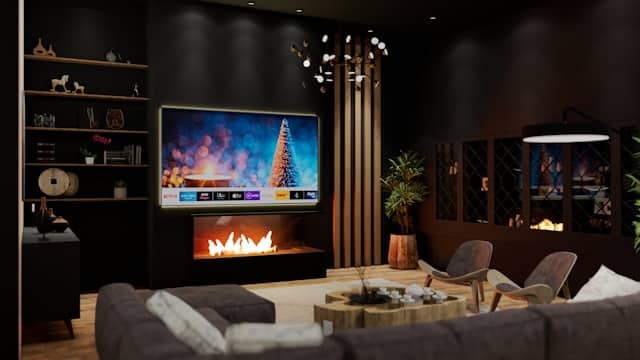How Can You Design a Home Theater with Acoustic Panels for Optimal Sound?

With the right guidance, crafting a home theater that delivers cinema-quality sound is not an impossible feat. It’s a meticulous process, starting from the selection of the right technology such as the LHR bass or the octane waves, to the design of the room including seating arrangements and choice of materials. The ultimate goal is to achieve optimal acoustics, making every film or music piece you play a sensational auditory experience. This article will guide you through each step of the process, ensuring you have the necessary knowledge to design a soundproof home theater with acoustic panels.
Choosing the Perfect Room for Your Home Theater
The selection of the room is a crucial first step in designing your home theater. A room’s size, shape, and materials present can significantly impact the acoustic quality.
A lire également : How to Set Up a Safe and Inviting Home Daycare for Multiple Age Groups?
To achieve the best sound, you will need a room that is roughly rectangular, with the screen placed along the shorter wall. The dimensions of the room should also adhere to the golden ratio of 1:1.6:2.6 (height:width:length) to minimize sound distortion and standing waves. High ceilings are beneficial as they prevent the reflection of bass frequencies, which can lead to a muddled sound.
Once you’ve selected a suitable room, it’s time to look at the materials present in the room. Hard surfaces such as wooden or tiled floors can reflect sound and create echo, which can distort the audio clarity. Carpeted floors or area rugs can counter this effect by absorbing the sound.
A lire aussi : What Are the Best Moisture-Resistant Materials for a Basement Home Gym?
Seating Arrangements and Furniture Selection
The next step is to consider the seating arrangement and type of furniture. The position of the seats can significantly affect sound quality.
The prime listening position, often the central area of the room, should be at least 1/3 away from the rear wall to avoid bass buildup. For your seating, you might want to consider investing in reclining leather sofas from reputable brands like Fortress. Not only do they offer comfort, but the leather material also helps in absorbing sound, thus improving the overall acoustic.
Avoid placing seats against the wall as it can lead to an uneven distribution of sound, making the audio louder for some viewers. If you plan on having multiple rows of seating, each row should be elevated to ensure that every viewer gets an unobstructed view of the screen.
Utilizing Acoustic Panels for Soundproofing
Acoustic panels play a significant role in managing the sound in your home theater. They help control the acoustic properties of the room by reducing echo and controlling reverberation.
For the best results, acoustic panels should be placed at the first reflection points on the side walls, rear walls, and ceiling. These are the areas where sound from your speakers will hit first before reflecting back to your listening position. Panels should also be placed behind the speakers to absorb low-frequency waves and prevent them from reflecting off the wall.
When choosing acoustic panels, consider those with a high Noise Reduction Coefficient (NRC). An NRC of 1.0 means that the panel absorbs 100% of the sound that hits it, whereas an NRC of 0 means that all the sound is reflected back into the room.
Incorporating Design Elements in Your Home Theater
While acoustics are crucial in a home theater, aesthetic appeal is just as important.
One suggestion is to install decorative wall panels or art that also serve as acoustic panels. These combine style with functionality and can blend seamlessly with your theater’s décor. Additionally, consider using diffusers – devices that scatter sound waves in different directions – to further enhance the sound quality.
Choosing the right color scheme can also impact not only the room’s design but also its acoustics. Dark colors absorb more light and sound, which can enhance your viewing and listening experience. However, if you want the room to feel more spacious, lighter colors might be a better choice.
With careful planning, a bit of technical know-how, and a keen eye for design, designing a home theater with optimal sound is not only achievable but also immensely rewarding. Whether you’re watching a blockbuster movie or hosting a sports night, the auditory experience will be nothing short of extraordinary.
Selecting and Installing the Right Acoustic Panels for an Optimal Sound Experience
Now that we’ve covered the basics of room selection, seating arrangements, and furniture selection, let’s dive into the world of acoustic panels. These elements are pivotal in enhancing the sound quality in your home theater.
To start, acoustic panels are not all created equal. They are available in various materials and designs, each with a different ability to absorb, diffuse, or reflect sound waves. For instance, porous absorbers like foam panels are excellent for absorbing high-frequency sounds but less effective for low-frequency sounds. For the latter, bass traps – specialized panels designed to absorb low frequency sound waves – are a more effective solution.
The selection and positioning of these panels require a thoughtful and strategic approach. As a general rule, the panels should cover about 20-30% of the room’s surface area, with more coverage needed for rooms with many hard, reflective surfaces.
Primary reflection points – the areas where sound from the speakers bounces off the walls and ceilings – need particular attention. Installing acoustic panels on these spots can mitigate sound reflection, ensuring a clean and crisp sound quality. Behind your theater seats and around the screen, bass traps can be beneficial to manage low-frequency sounds that might muddle the audio.
For a more personalized approach, consider investing in octane seating with built-in acoustic panels or even a power headrest with integrated speakers. These provide a more immersive audio experience by bringing the sound closer to the viewers.
Conclusion: Bringing It All Together
Designing a home theater with acoustic panels for optimal sound is an exciting project that calls for both technical understanding and creativity. From selecting the perfect room, arranging your theater seating, to installing the right acoustic panels, every step plays a pivotal role in shaping the theater’s sound quality.
Remember, the overall goal is to achieve a balance between sound absorption, diffusion, and reflection. Too much absorption can make the room sound ‘dead,’ while too many reflections can cause echo and muddied audio.
When chosen and installed correctly, acoustic panels can drastically improve your audio experience, making every movie or music piece resonate as though you’re at a professional movie theater. Coupled with comfortable seating fortress or octane seating, the result is an inviting and immersive home theater room that promises countless hours of high-quality entertainment.
Lastly, don’t forget that home theater design is not a one-size-fits-all. Each room is unique, and what works for one might not work for another. Experiment with different panel placements and seating arrangements until you find what suits your space the best. Enjoy the journey – after all, building a home theater is as much about the process as it is about the end result. Happy viewing!
